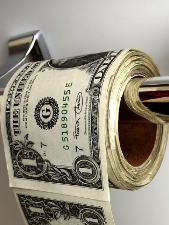 There’s something about money that gets people talking!
There’s something about money that gets people talking!
That’s what happened with my first post on $100 training sessions last week. In that post I set-up the subject and it resulted in some strong input from readers.
Just like last time, I’ll open by saying that money’s not everything when you’re an independent trainer. When I first went solo I put money first and was quickly frustrated and burnt out. What I realized is that the approach to being a high level solo trainer is different. It’s about doing a few things really well – about quality. It’s at that point that your rates can go up so you don’t have to work a ton of hours to make the money you want.
But you still of course want to GET PAID! This is a free market, so if you’re doing a better job than the next guy you deserve to get paid for it. If you’ve figured out how to create a demand for your training services, a superior training product, deliver better results, or have turned yourself into the kind of person people want to be around, these are marketable qualities so yes, you deserve more money. If not, just implement a few of the principles we talk about on this blog and see what happens – you’ll be on a higher level than most of your competitors. Not taking advantage of that position makes you a communist!
Ok I digress …
Luckily for me the mental barrier to $100 training sessions was broken early. But being pretty new as a trainer and not always training in affluent areas, I had to use some unconventional techniques to get to that level.
 The main thing that has done it for me are semi-private sessions. They got me to over $200 per session net during peak hours. I know, putting multiple clients in a single session is cheating, but I think this is the most valuable technique that trainers have at their disposal to raise their incomes. It’s the most reproducible in almost every situation and the easiest to pull-off for someone new to training or on a limited marketing budget.
The main thing that has done it for me are semi-private sessions. They got me to over $200 per session net during peak hours. I know, putting multiple clients in a single session is cheating, but I think this is the most valuable technique that trainers have at their disposal to raise their incomes. It’s the most reproducible in almost every situation and the easiest to pull-off for someone new to training or on a limited marketing budget.
That’s why I’ve given it this entire post. Here I’ll describe a few of the situations where I’ve pulled of successful group sessions -they should give you some ideas on how to apply them to your situation.
The “Problem”
The problem with semi-private sessions is pretty minor when you think about – it’s to overcome the fear of rejection from brining this up to your existing clients. If you’re just getting started in training this might be news to you, but good trainers are extremely rare and highly in demand. Once your client gets comfortable with you, they will be very hesitant to work with someone else.
In Studio
A studio is the easiest environment to implement semi-private sessions. There are just tons of psychological factors that fall in your favor when you have a client on your turf in a captive environment. When you have your own place you’re viewed as more in demand, more credible, and having more authority.
It started for me when I got to the point where I had a very hard time scheduling my clients for one-on-one sessions during peak hours. This was inconveniencing them and driving me crazy. I realized something was going to have to give, so one day I got over my fear and suggested to them that I would have to double them up sometimes during their sessions. Absolutely no one had a problem with it – they were actually quite happy to make things easier on me and help me make more money. It was then I realized the leverage that we really have as trainers.
As my business grew I had at least 3 and as many as 6 clients showing up to every session. I was charging only $60 per session here, but even after paying my assistants and my expenses I still regularly took home over $200 an hour during peak times.
Now I know what you’re going to say – I should have figured out way to cut myself out of the equation totally so I could make the same money without being present. But for a trainer starting out, this is a good way to bring in a good hourly until you can write yourself out of the equation.
Outside of a studio
You probably don’t have the advantage of a studio and may have no desire to open one, but you can still use semi-private training in other situations.
 When I first started training in Manhattan, I had to do it out of trainer’s gyms. There was one good place that I found around Midtown that was in a good location, had low fees, and was convenient for basically anyone to come to after work. This is when I first started using a website to get clients, so I was able to build up a little demand pretty quickly. I was sure to establish a lot of credibility through the site and in my first few sessions with the client and in just a few weeks had my sessions double booked again during peak times.
When I first started training in Manhattan, I had to do it out of trainer’s gyms. There was one good place that I found around Midtown that was in a good location, had low fees, and was convenient for basically anyone to come to after work. This is when I first started using a website to get clients, so I was able to build up a little demand pretty quickly. I was sure to establish a lot of credibility through the site and in my first few sessions with the client and in just a few weeks had my sessions double booked again during peak times.
By now, running semi-private sessions was old hat, and even in a training gym with other trainers around I was able to run these semi-private sessions with the help of my assistant (this assistant was just a buddy of mine by the way). I always had two clients show up to these sessions paying $85 an hour, and every now and then I could even triple book them. The trainer’s gym charged me $15 for the first client in an hour, and $10 for every one after that – so when you take it all into account, I still pulled in at least one hundred and sometimes $200 for the hour.
The key to this was differentiating myself from the other trainers. Low-level independent trainers in general are a lazy group. This gym was packed with trainers, but they were all in jeans or sweats, b.s.ing with each other, not taking notes, and in general were no competition. My clients never thought about training with anyone else, even though there were a lot of trainers around. When I eventually decided to stop training in Manhattan and had to drop these clients, most of them unfortunately stopped working out altogether rather than work with one of these other trainers.
Outdoor Sessions
 If you have a warm climate you can obviously do semi-private sessions in an outdoor setting. There’s just something about being outside that makes these sessions more fun. If you’re used to seeing clients outdoors anyway, you can just double book them in the hours that are highest in demand.
If you have a warm climate you can obviously do semi-private sessions in an outdoor setting. There’s just something about being outside that makes these sessions more fun. If you’re used to seeing clients outdoors anyway, you can just double book them in the hours that are highest in demand.
Even though I keep my training hours under control, I definitely am a busy guy so it isn’t hard for me to justify why I need to schedule multiple clients in the same hour. You don’t have to double them up every session, but even if you do for a half to a third of their sessions, you’ve still hit $100 (depending on how much you charge).
One thing to point out is that with the clients you move to semi-private, you should “warm them up” with private training first. You want them to get used to you and establish a baseline of trust, and then you can suggest sharing a session and see how they react to it. If they like you there shouldn’t be a problem.
In the last part of this series we’re going to talk about how to get your rates up to $100 for a private, one-on-one session.
Until then I recommend everyone to give semi-private sessions a shot if you haven’t already. The main thing holding back any trainer is fear. But you just need to open up and realize how valuable you really are!
____________________________________________________________
The blog is just the beginning!
For the real-talk no one’s saying on the web, read :
The UNDERGROUND NEWSLETTER
Sign-up below (your email address WILL NOT be shared):

Kaiser
You have some interesting points, but personally I dont train groups. I own the studio and with 30min w/o’s groups dont make financial sense, number 1 reason is – YOU cant do groups in 30mins,,,,,, 2, they always want a deal of some sort (due to semi-private), all my other sessions are private, and lastly groups are much harder to train. Now, instead of 1 person you have several to keep track of, and the workout intensity really suffers.
Hey Kaiser, cool post as always
By the way, you’re definitely a big hit with my blog readers
Regarding semi-private training, my ENTIRE training business is based on that. Typically six people at a time, and often we charge as much as your typically one-on-one trainer per person in the group, pulling in close to $300 an hour
All about positioning, I was able to get clients to see my way immediately that there’s 7 reasons why you DON’T wanna train with a one-on-one trainer and that groups are the ONLY way to go
Semi-private/group training works best in my business for about 37 different reasons
thanks again bud
I just started applying these semi-private sessions – it’s all win-win. They pay a bit less per session and you make way more money.
On another subject real quick: That latest Underground newsletter was good man. We’re all striving to be that next Gunnar who doesn’t need longcopy.
I did some small group training years ago but found I preferred one-on-one. However, it now makes perfect sense in making the best use of my time and earning potential. Like you mentioned to Rivak in a previous post, it’s easy to let your job take over your life and end up putting in endless hours. This blog has been a big help in getting me to think out-of-the-box (most overused phrase, I know) in terms of session times (30, 60, 90 minutes), pricing, approaches to training, and mindset. I love what I do but I’m always looking at ways to work less and make more in order to be more balanced and avoid burnout. Many thanks Kaiser and everyone who contributes with their comments!
That’s a great point you made that if the clients like you, then they’d be more than happy to help you out. This has been my experience as well.
I’ll have to apply this to semi-private groups in the near future. I can even see how training in small groups can develop a kind of supportive team atmosphere for the groups you train that can cancel out the fact the the client gets less personal attention from the trainer.
Good tip on starting a client 1 on 1 and developing that rapport first, too – before moving them to group training.
Awesome input from everyone on leveraging time. And great post on Chris’s blog too, Kaiser!
Yeah DG, some real good input here on the subject from all sides of it – I love throwing these topics out there and watching the big dogs chew on it!
Some good points made here – good one Chris on positioning the service – In my case I positioned the trainer (ie myself) which gave me the leverage needed, but positioning the service gives you even more leverage if you can do it right –
I agree with you Bill on the fact that service suffers – that’s why you notice beyond two people I always bring someone else on board to help me – I don’t HAVE to do this – it’s just something I do to maintain my own standards – after all, I do not decrease the price, so I’m still compelled to give the same value –
Yeah Mike – once you get them hooked on the groups try to slowly up that price every few months –
Yeah DM, I think paying attention to all these things is the FIRST, most obvious but sill overlooked way to raise income and cut hours – you can then start looking to other things –
Can you have Chris McCombs post the 7 reasons why you DON’T wanna train with a one-on-one trainer and that groups are the ONLY way to go?
That would be a Killer resource!
PS: I already signed up for the Underground PT Course, can’t wait!
I do a fair bit of semi-private training, but approach it a bit differently. My semi-private clients organize themselves. What I’m talking about here is couples and groups of friends. In my experience, they are not hard to find. When I have a new prospective client, I’ll often mention that they can train with a spouse or group of friends. More often than not they are immediately interested. Not only is this more lucrative than private sessions, but it is also a lot of fun because there is built-in camaraderie already!
Cheers,
Adam
Great article, Kaiser! I’ve been back-and-forth on whether I should open up a small group training program. I was thinking of promoting it on its own and having people sign up for monthly memberships just as I do with my classes, but the idea of asking your existing private clients to pair up is something I haven’t thought about. Good stuff.
Hey Kaiser, really good post. In fact, last June I did a small workshop for trainers who looking to open a personal training studio. One of the main business models that we covered were what I call “team training” programs. Like you said, they make the trainer more money, they cost the client less, and it kicks retention into high gear because there’s a sense of competition – everyone wins.
Bedros
Hey Kaiser,
Sorry about the late response to this post, but I have been mulling it over in my mind the past couple of days. Your idea is stellar and makes perfectly good sense from a business leverage point of view. I have tried to make a go of this with massive print marketing,($5K per mailing) Google Adwords and word of mouth, but have NEVER had anyone express interest.
I don’t believe I am an isolated case. My one-one marketing is cutting edge. I would love to get some ingenius ideas from the peanut gallery on how they market differently from what I previously mentioned.
Hi Kaiser,
Great post as always! I just recently decided that small groups is the only way for me to go. I specialize in Boxing fitness training for women. I just started small group last year, but the commitment level of these ladies is so exciting. I train (3-8) at one time. Once you start training like this it’s very hard to go back to just doing one -on -one sessions(I know for me it is)
I love the way the ladies feed off of each others energy, not to mention I make more money in one session.
Bill Moore, you really should give it a try. I used to do circuit training using 30 minute workouts, I think that it is an excellent way to train more clients at one time. I could train up to 10 people in one circuit and give them a great workout, and see lots of results. Best Wishes
I am looking to go that way myself. As I grow before and after work are the peak times. If I stick with one on one I will have to pass many people up limiting my income and the number of people I can help. I do think this is the best way to go. One question, now many people to you take on at once before you get someone to help?
Just started to adapt semi-private training sessions with some of my clients. They absolutely love the idea and now I am making 100 a session. Such a simple idea brings great results! Thank you Kaiser for having this site.
Kaiser,
This kinda goes with this, but I am confused as to what is better to go with. Is it private sessions or group boot camp things. Cause like you state you worry about your quality going down with the more people you train at one time. But, I also go on Bedros Keuilian’s site and he says private sessions are dead. And he interviewed a trainer that says he only does group sessions and charges like $30. He said he is more successful because he will have 30 clients versus the 15 a more expensive trainer will have. If you could shed some light on this I would appreciate it.
An excellent trainer I know has real success pairing up folks to train. And, in the studio where I work, we have a couple of two-somes. They egg each other on and, even when workiing hard they smile and laugh; there’s real camaraderie, there and, sometimes, a trainer, by getting ’em to do a little one-on-one guarding and evading (basketball without the hoop) and compete with each other in different ways, can get them to work harder than they might if only one of ’em was under the cracking whip. (The downside is, if they start talking about something, it can take their eyes off the prize and if one’s in a down mood and the other’s not happy, it can hamper both trainees’ enthusiasm and the trainer may have to work harder to motivate.